Thyssen Art
Saturday, July 23rd, 2011
| Back in June 2010 we predicted that Germany was due to be subjected to a whitewash documentary about The Thyssen Dynasty; made by Broadway TV for transmission by ARD. We hoped our prediction would be proved wrong, but not a bit of it. In fact the program was even more of a ‘hagiography’ than we had foreseen. It appeared to have been yet another attempt by ThyssenKrupp, doubtless with the assistance and encouragement of The Fritz Thyssen Stiftung, to clean-up their past, mainly by omissions rather than lies. Even the members of the Thyssen-Bornemisza main branch of the dynasty were obviously too embarrassed by the whole ghastly project to want to take part. The only exception was Francesca Habsburg who appeared in support of the accusations against Tita Cervera and charges of her responsibility for attempting to steal the family fortune and polute the Thyssens’ ‘noble’ reputation.
Meanwhile the same old historical myths were reheated and served up yet again. We were encouraged to believe that Fritz Thyssen had seen the error of his early support of Hitler and the Reich and paid a heavy price for his resistance. No mention was made concerning his tax evasion and illegal foreign currency transactions. They also claimed him to be considered a German hero for opposing the Versailles Treaty, the allied occupation of The Ruhr and the stringent reparation payments imposed by the allies. This was of course hardly something that could be considered unique. In fact Germany as a nation has been ‘somewhat remiss’ in paying their debts for either World Wars. We were also asked to believe that Fritz had really rather liked Jews and even had some as personal friends.
At the same time, Heini’s father Heinrich Thyssen-Bornemisza was treated with a great deal less generosity, presumably because, following our revelations, they were obliged to admit that throughout the war he had continued to profit from his industrial contribution in supplying armament for the Reich. It was also made to sound like an activity entirely independent of the Thyssen organisation. Predictably, no mention was made of his banking and financial contribution. They even got Federico Zichy-Thyssen to claim that his uncle’s behaviour had rubbed off on Heini and that his grand-mother had warned him ‘never to do business with Heini’. He didn’t mention that the same grandmother had joined the Nazi party three years before her husband and returned from South America after the war to take charge of the Thyssen organisation and found The Fritz Thyssen Stiftung. But he did remind us how much unhappiness his fortune had brought him and how his children constantly fought over their inheritance; which must have sounded familiar to Francesca.
Then the story moved on to the Rechnitz Massacre for which the program makers wheeled in none other than Wolfgang Benz, the retired professor of antisemitism research at Berlin University; the same Wolfgang Benz who originally reacted to my feature in FAZ by denying that the massacre had ever taken place. Making no mention of his original claim, or why he had changed his mind. In an effort to eliminate Margit Batthyany-Thyssen as a suspect he insisted that only uniformed Nazis had been involved in the massacre, though he gave no evidence to support his claim. The program even claimed that Margit hadn’t known about the massacre until she was told the following morning. Paul Gulda, of all people, then insisted that Franz Podezin, one of the main perpetrator, had only been ‘following orders’! He even mentioned the ficticious telephone call that so many apologists claim to have instructed Margit’s lover to shoot the Jews. But the fact that she had helped two of the guilty to escape justice was ignored. I was mentioned as the author of ‘The Thyssen Art Macabre’ which was dismissed by the program as being inaccurate and disregarded by ‘experts’. They also claimed that I had accused Margit of actually shooting some of the victims of the massacre herself, which I didn’t, despite being quite convinced she did, but unable to prove such an accusation. They insisted it was not a book that should be taken seriously, without giving any reason why they were mentioning it in the first place.
Broadview TV then moved on to more recent times by claiming that Heini, who Simon de Pury described as the best collector of his time, had ‘donated’ his art collection to Spain, while Francesca insisted that the only reason why the Bermudan court case had collapsed was because his children had withdrawn all charges so that their father could die a happy man, despite Tita’s attempts to get her hands on all his money.
Finally the program makers brought ThyssenKrupp back into focus by getting its long-time Chief Executive Dieter Spethmann to say what a deeply wonderful company it was and how much it had contributed to Germany’s wealth, well-being and economic miracle. Since the documentary was shown, the company has announced plans to cut its global workforce by some 25% and admitted that the recent sale of shares was an effort to reduce its enormous debts.
It is doubtfull that even such a misleading documentary could have any effect on the fortunes of ThyssenKrupp or the Thyssen families (either Zichy or Bornemisza) but if the program had been more accurate and less misleading at least, ThyssenKrupp, The Fritz Thyssen Stiftung, ARD and Germany’s academia may have retained some degree of credibility. |
 Portraits of Elisabeth and Dieter Spethmann by Warhol. |
Tags: ARD, Berlin University, Broadway TV, Dieter Spethmann, Federico Zichy-Thyssen, Francesca Habsburg, Franz Podezin, Fritz Thyssen, Fritz Thyssen Stiftung, Heinrich Thyssen-Bornemisza, Margit Batthyany-Thyssen, Paul Gulda, Rechnitz Massacre, Simon de Pury, ThyssenKrupp, Tita Cervera, Wolfgang Benz
Posted in The Thyssen Art Macabre, Thyssen Art, Thyssen Corporate, Thyssen Family Comments Off on The Thyssen Dynasty – “As seen on TV”
Wednesday, June 23rd, 2010
Go and see Picasso’s Guernica at the Reina Sophia Museum to be warned of the horrors of war.
Go and see Ghirlandaio’s Giovanna Tornabuoni and 999 other paintings at the Thyssen-Bornemisza Museum to be reminded of the profits of war.
|
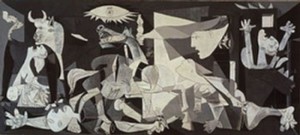 |
Tags: Ghirlandaio, Giovanna Tornabuoni, Guernica, horrors of war, Picasso, profits of war, Reina Sophia Museum, Thyssen-Bornemisza Museum
Posted in The Thyssen Art Macabre, Thyssen Art Comments Off on Visiting Spain? Looking at Art?
Monday, June 21st, 2010
| Back in February we learned that Broadview TV in Cologne was producing a documentary on the Thyssens to be shown on German television (ARD channel) later this year as part of their ‘German Dynasties’ series. This was interesting news, as we knew that for several years such a venture has been planned in Germany but had so far failed to materialise.Following the publication of our book, a major rewriting of the family and corporate history was initiated, co-sponsored by the Thyssen corporation (via Fritz Thyssen Foundation) and the Thyssen family (represented by Georg Thyssen-Bornemisza). Now Broadview TV was announcing that their film (see this Scanned Document) would feature ‘August, Fritz and Heini Thyssen’, making no mention of either Heini’s father Heinrich Thyssen-Bornemisza, a key figure of the story whose role we have researched and reported extensively, or Fritz’s wife Amelie, who was a committed Nazi, yet regained ownership and control of the corporation after Fritz’s death in Argentina (not in Germany) in 1951, while never publicly recanting her political beliefs.
Instead, Broadview TV announced that their emphasis would be on ‘Fritz Thyssen’s TRAGIC embroilment with the Third Reich’ as well as ‘the patron of the arts Hans Heinrich Thyssen-Bornemisza’.
For a brief moment we paused to think what Heinrich and Heini Thyssen, who had spent most of their lives aggressively denying their Germanness, would think about being turned back into ‘Germans’ posthumously! And hadn’t Fritz and Amelie always insisted they were stateless? In my opinion as a German it is wrong for the German public to be asked to accept this family back into their national consciousness as one of their own, without being given the chance of seeing an unbiased picture of BOTH their achievements AND their failings.
We are not in any way denying the Thyssens’ achievements. They created a vast industrial empire, thousands of jobs and careers as well as wealth for the German nation and beyond. To be more precise, August and his brother Josef did those things, as well as their workers, foremen and managers. But Fritz (& Amelie) and Heinrich Thyssen were big cogs, very big cogs indeed in the process that brought Adolf Hitler to power. As such, the Thyssens’ ‘embroilment’ with the Nazis was NOT, I repeat NOT tragic for the Thyssens. The Thyssens were not victims. They were perpetrators. They supported the Nazis because they wished to eradicate Communism and Socialism and ensure their own profits and lifestyles.
The actual tragedy was the one that befell the people of Europe and of the wider world who died in their millions or survived to live on with their haunting memories. More often than not they were offered no support to come to terms with their experiences, while the Thyssens were allowed back into the position of role models. Now they’re reintroduced into the German media and, in our opinion, instead of owning up fully to their historic role, commission sanitised reports which airbrush inconvenient truths out of the public picture. This is evident in recent publications where embarrassing facts were circumvented or ignored.
We decided to contact Mr Dehnhardt to try and find out what kind of course he was planning to take with his documentary. Having written to him early in February we heard nothing. So we wrote to the Head of ARD, Mr Peter Boudgoust. He wrote back a very nice letter, saying he had passed our concerns on to the commissioning editors, in this case Christiane Hinz at WDR in Cologne. But we heard nothing from Mrs Hinz, even when emailing and phoning her.
Finally, after another letter to Mr Boudgoust, Mrs Hinz replied. She suggested our worries were ‘unfounded’, that the ‘POSSIBLE film about the Thyssens’ was still ‘ONLY AT A PROJECT STAGE’, that ‘all relevant historical points’ would be researched and that ‘if any questions arose that only [we] could answer’ they would ‘of course’ contact us. No apology was made for her previous silence.
Now finally – after 4.5 months – Mr Dehnhardt too has chosen to communicate with us, though rather pointedly, he has addressed his reply (see enclosed) to David only, not to myself, his German kinswoman, although our letter came from both of us. Once again, like Mrs Hinz before him, Mr Dehnhardt points out that ‘all relevant themes, including those from the time of the Third Reich’ will be dealt with, but adds ‘you have no right to expect for the interpretations derived from your research to be given an automatic platform in our programme’. He also bemoans our sceptical approach, stating that it is ‘devoid of any reality’, particularly in view of the fact we ‘know nothing about the concept, form and content of [his] film’. Meanwhile, however, he still fails to communicate any of the concept, form and content in the professional manner that we would expect.
The word ‘interpretation’, of course, is a very interesting choice in this context, as it carries all the connotations of ‘spin’. The fact is that if you leave Heinrich Thyssen-Bornemisza and Amelie Thyssen out of the picture, you refuse to deal with real historical issues, namely those of managing German companies throughout the war from a Swiss safehaven, including the use of slave labour, international Nazi banking, the Rechnitz Massacre, the Thyssens’ post-war protection from Allied retribution, etc, etc, etc. These are straightforward facts; not ‘interpretations’.
Mr Dehnhardt has been criticised in the past for producing a documentary in which the views were said to have been over-emotional and unbalanced. Kultura Online Magazin found that his film on the battle of Stalingrad did not give a voice to the Russian side and only described the results but not the reasons for the historic developments in question. When confronted with this criticism, Mr Dehnhardt replied: ‘I think the individual [German] soldier also has the right to be a victim, especially in the context of Stalingrad. My film shows that he was only a small cog in a big machine’.
Here Mr Dehnhadt is right. But this statement begs the question as to how he will deal with the ‘big cogs’ when it comes to his documentary on the Thyssens. Will he still have the likes of his father (or my father and uncles for that matter) in mind or will he now bow to the power and influence of the cosmopolitan ‘big cogs’? Will he tell the German public the tale of Fritz Thyssen suffering in a concentration camp, although we established he was under comfortable, protective custody while his brother Heinrich continued to supply the Nazis with coal, submarines and aerial torpedoes from the safety of Switzerland? And will he tell people what an art expert Heini Thyssen was when we showed that Heini Thyssen himself told us his father had bought the collection simply in order to transfer money out of Germany and Thyssen art has been used and abused as a convenient veneer behind which to hide a guilty past ever since?
We shall have to wait and see. But after our experiences of looking into all things Thyssen for over fourteen years, we remain sceptical, particularly since Mr Dehnhardt makes several films on different subjects every year. In this short space of time he could not possibly have enough insight into a vast topic such as Thyssen to offer anything but a simplified view. A view that is in danger of misrepresenting the past in a way that will once again allow the Thyssen big cogs to indulge their privileges while shunning their historic responsibilities.
We really hope to be proved wrong, because for the last seventy plus years the German public has been misinformed regarding Thyssen. We believe that while they may not like the image of the Thyssens that we have revealed, it is up to them, not to what might prove to be a Thyssen-influenced media company, to decide.
The programme was finally aired on 8 November 2010.
COMMENTS:
eldeadpixel writes: Thanks for this good article. I wonder if that documentary will be shown here in Spain… Keep us up to date! |
 Sebastian Dehnhardt, film producer and managing director of Broadview TV, Cologne 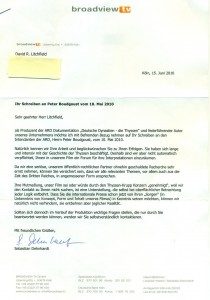 Four and a half months for a reply - And they call us 'illogical'... |
Tags: Adolf Hitler, Amelie Thyssen, ARD, Argentina, Broadview TV, Christiane Hinz, Communism, Fritz Thyssen, Fritz Thyssen Foundation, Georg Thyssen-Bornemisza, Heinrich Thyssen-Bornemisza, Kultura Online Magazine, Nazi Banking, Peter Boudgoust, Rechnitz Massacre, Sebastian Dehnhardt, slave labour, Socialism, Stalingrad, Switzerland, WDR
Posted in The Thyssen Art Macabre, Thyssen Art, Thyssen Corporate, Thyssen Family Comments Off on Is B r o a d v i e w TV’s Sebastian Dehnhardt helping the Thyssens to white-wash their history? (by Caroline Schmitz)
Sunday, March 28th, 2010
| Interview with Sara Olivo for Epoca Magazine (Gaceta de Negocios) 12 March 2010.
EM: Do you think that Carmen Cervera and the Spanish State will come to an agreement for the Carmen Thyssen-Bornemisza Collection to remain in Spain?
DL: I hope not. The Spanish state does not need her pictures. And Carmen Cervera should not be asking the Spanish state for any payment. The Spanish state cannot afford it and the Madrid museum already loses money every year. So why pay more money to a wealthy Thyssen in order to lose even more money for the state? For the life of me I cannot think of a reason why Spain wants Carmen Thyssen’s third-rate pictures, when it already has too many first-rate pictures in other museums.
EM: What are the main difficulties faced by Tita to reach a satisfactory agreement?
DL: The main problems are her greed and Spain’s bad financial situation. She is trying to repeat the deal that her husband Heini made nearly 20 years ago. But she does not have his skill or knowledge. You did a terrible deal with Heini Thyssen. Even some of your own experts expressed scepticism about the wisdom of Spain buying his collection in 1993, for instance Eduard Castellet, President of the Fundacion Miro. So why would you want to do another, even more terrible deal?
EM: She says that she has offers from some museums in the USA and Europe. Can this be true?
DL: No, I don’t think that’s true. If she did, why would she not name them and say what they are offering her?
EM: She says she has as much money as people think…..Is it true?
DL: Her worth is never going to be what she says it is. I’m not sure she would even know herself. If she can claim that her pictures are worth €700 million, then of course she can claim to be a billionairess. But I believe that all of that is totally and completely exaggerated. Anyway, what does it matter how much money she has? She is taking money from Spain, not giving it.
EM: Is the Thyssen Collection overrated? Tita says it is worth €700 million.
DL: The Thyssen-Bornemisza Collection (i.e. Heini’s collection sold to Spain in 1993) is worthless, because it cannot be sold and requires constant taxpayers’ support to be housed and exhibited. As far as the Carmen Thyssen-Bornemisza Collection is concerned, as Carmen Cervera never says exactly what her collection comprises (240 pictures? 900 pictures? 3000 pictures?), it is impossible to value it. Therefore, what she is saying about its value is of no consequence. It is interesting, for instance, that the Spanish state seems to be insuring 655 of her pictures, when officially she is only exhibiting 240 at the Madrid museum:
http://vlex.com/vid/prestadas-coleccion-thyssen-bornemisza-15449009
EM: Can the negotiations affect the dispute between Tita and Borja and visa versa?
DL: Negotiations for what? She never says what she is negotiating. She constantly changes the number and nature of the pictures she wants Spain to rent from her. In Malaga, she is talking about a catalogue of 200 pictures, which only the conservative mayor has ever seen (not even the left-wing opposition in the town council has had the honour). The deal in Sant Feliu de Guixols is even more obscure, and yet she is talking about a ‘Thyssen museum network’ between the three locations. In the meantime, I calculate that Spain has already spent a total of around €100 milllion (!) to build facilities in Madrid, Malaga and Sant Feliu de Guixols to house parts of the Carmen Thyssen-Bornemisza Collection. If she is negotiating about pictures which are part of her son Borja Thyssen’s inheritance rights, then obviously he could challenge any deal.
EM: Do you think that being such a populist politician, Prime Minister Zapatero has a real interest in the collection with such a financial crisis as we currently have in Spain?
DL: I don’t understand why anyone, regardless of their political beliefs, would want to pay for pictures, some of which the Spanish state has already rejected before and others which were purchased from money previously paid to the Thyssens by the Spanish tax payer. It would be a bit like paying for the same thing twice!
EM: Tita said that the topic of her private collection is independent of the negotiations on the future of the Thyssen Museum. Do you think this is true?
DL: Carmen Cervera’s pictures housed in the Madrid museum since 2004 were not part of the original agreement with Heini, for which Spain paid $350 million in 1993 (according to my figures it was actually closer to $600 million if you include the real estate, architectural costs, insurance, lawyers fees, administration, etc,. etc.). Heini Thyssen did, however, manage to get a foot in the door for his wife by signing a separate agreement to loan an additional 70 pictures to the Madrid museum which remained in the ownership of him and Tita. This seems to be the basis of what she is trying to negotiate for Madrid now. This leads to an interesting point, which is that very few Spanish people (if any) have ever seen the original agreement. I have seen it, which is why I know that Spain made such a terrible deal.
I believe, that as a Spanish tax payer, you have the right to demand concrete information about all of this. At the moment, it is still all shrouded in a veil of smoke and mirrors. I can think of no reason why anyone would even consider acquiring her pictures, unless they are being paid some form of commission for doing so. On a personal level, I would also like to say that in my eyes, Carmen Cervera’s vulgarity and lack of taste actually damages Spain’s cultural image internationally. One more thing, which is very important: neither Tita nor Borja can do anything to affect the status of the original paintings bought by Spain from Heini Thyssen. Some reports make it sound like she could take Heini Thyssen’s pictures out of the Madrid museum as well. She cannot! |
 More, More, More, More, More, More, More, More, More, More, More, More, More, More, More, More, More, More, More, More, More, More, More, More, More, More, More, More, More, More, More, More, More, More, More, More, Mas, Mas, Mas, Mas, Mas, Mas, Mas, Mas, Mas, Mas, Mas, Mas, Mas, Mas, Mas, Mas, Mas, Mas, Mas, Mas, Mas, Mas, Mas, Mas, Mas, Mas, Mas, Mas, Mas, Mas, Mas, Mas, Mas, Mas, Mas, Mas, Mas, Mas, Mas, Mas, Mas, Mas, Mas, Mas, Mehr, Mehr, Mehr, Mehr, Mehr, Mehr, Mehr, Mehr, Mehr, Mehr, Mehr, Mehr, Mehr, Mehr, Mehr, Mehr, Mehr, Mehr, Mehr, Mehr, Mehr, Mehr, Mehr, Mehr, Mehr, Mehr, Mehr, Mehr, Mehr, Mehr, Mehr, Mehr, Mehr, Mehr, Mehr, Mehr... |
Tags: Borja Thyssen, Carmen Cervera, Carmen Thyssen-Bornemisza Collection, Eduard Castellet, Epoca Magazine, Fundacion Miro, Gaceta de Negocios, Heini Thyssen, Madrid, Malaga, Sant Feliu de Guixols, Sara Olivo, Spain, Thyssen Museum, Thyssen-Bornemisza Collection
Posted in The Thyssen Art Macabre, Thyssen Art Comments Off on Will Spain Give The Thyssens A Second Gold Hoard?
Saturday, February 20th, 2010
 (photo: ABC newspaper, Spain)
Posted in The Thyssen Art Macabre, Thyssen Art Comments Off on
Saturday, February 20th, 2010
| It may be very sad but if there was ever an image that sums up what has become of Spain’s once great cultural heritage, it is this photograph (see above) of The Baroness of Bad Taste, Duchess of Greed, arriving in her gross ‘Panzermobile’ at ‘her’ museum.
As the excrement of corruption, greed, chat TV, celebrity-obsessed society and ‘dollar art’, as reflected in Hola, now covers whatever was once great about Spain and the true brilliance that undoubtedly still exists – and can even, occasionally, be seen through gaps in the scum – it becomes difficult not to believe that this is what the majority of Spanish people want or are prepared to accept.
They seem quite happy to have paid $600,000,000 for half of a second rate art ‘collection’ and spend yet further millions every year in subsidies, while this ugly recipient of their generosity demands yet more money.
So if, as it appears, their dreams really are now represented by Carmen Thyssen’s gross reality and overpriced art, then one can only accept the fact that she appears to be doing a very fine job.
Poor Spain!
http://www.abc.es/20100219/cultura-arte/carmen-thyssen-presenta-monet-201002191916.html |
 Lady ChaCha playing the Pink Joker (photo: Ines Baucells, ABC newspaper) |
Tags: Carmen Thyssen, Spain
Posted in The Thyssen Art Macabre, Thyssen Art Comments Off on Poor Spain!
Monday, February 15th, 2010
| Something is puzzling me.
Tomas Llorens Serra, ex-director of the Madrid Thyssen Museum, and now chief advisor of Carmen Thyssen on her planned Malaga Thyssen Museum, many years ago, told me personally that his academic background had been as a student of architecture at Portsmouth University in England, where he received his degree as an architect.
Of course, this would, in theory at least, qualify him to be part of the company (named by Miguel Ferrary in an article entitled ‘Disenar las entranas del Thyssen’ in ‘La Opinion De Malaga’ on 15 December 2009 as being ‘Nova Kiterea, based in Valencia’ – Mr Llorens’s hometown -, ‘created in August 2008 and of which Tomas Llorens is a ‘socio apoderado’) that is building the new cultural centre of Malaga, where Tita Thyssen, his ex-boss, is threatening to house her collection, or part of it. But it would not qualify him as an art historian or as a curator.
Perhaps this is the reason why on his CV at revistaarte.com he misses out all references to architecture and concentrates on the fields of law, aesthetics, philosophy and literature, which he seems to think did qualify him as an art historian.
(This comment was also posted by me today on this site at Diariosur newspaper, but taken down after 10 minutes. Not the first time, I might add, that a newspaper (Spanish or English for that matter) has censored my comments on the Thyssens! As the saying goes: ‘Just because you’re paranoid, doesn’t mean that they’re not trying to get you!…..) |
 TITA'S FRANCHISE DREAM  Is this man big enough for the job? |
Tags: Carmen Thyssen, La Opinion de Malaga, Madrid Thyssen Museum, Malaga Thyssen Museum, Miguel Ferrary, Nova Kiterea, Portsmouth University, revistaarte, Tita Thyssen, Tomas Llorens Serra, Valencia
Posted in The Thyssen Art Macabre, Thyssen Art Comments Off on Is Thyssen’s Tomas Llorens A Builder Or A Curator?
Sunday, January 10th, 2010
| At last! Spain begins to question the quality of the Thyssen-Bornemisza Collection, what the taxpayers might have got for their money and the wisdom of paying yet more money for ‘Tita’s Collection’. These were all things we have been publicly questioning for the last three years. So why has it taken so long? Without wishing to sound cynical, could it be a result of the credit crunch? While Spain was flooded with Euros, nobody wanted to see the King naked.
Today’s critic, Dr Juan Jose Junquera, is a Professor of Art History at Complutense University in Madrid, and as such could hardly claim to be a stranger to the collection. Perhaps the Thyssen-Bornemisza Collection Foundation Board, particularly Sir Norman Rosenthal, will now be obliged to make a comment, though with Rosenthal’s wife still working at the Prado, he could of course be accused of a conflict of interest.
The following is a translation of the Spanish original from today’s ABC newspaper.
No wonder Tita is busy preparing Villa Favorita in Lugano for re-occupancy. This feature looks to me like the Culture Ministry’s way of say ‘No’ to any further deals with Tita and if this one hits the buffers, Malaga looks ever less likely.
“After reading Carmen Cervera’s declarations in ABC on Sunday 3 January, I’ve had the following thoughts: I’m not doubting the generosity of her offer to loan the Thyssen Collection, but I’m asking myself of how much interest it actually is to the Spanish taxpayers. We still don’t know which paintings will stay in Spain once the current cession agreement concerning the collection of her late husband, Baron Thyssen-Bornemisza, ends, which was a question raised in its day by the then Director of the Prado, Professor Perez Sanchez, and to which there still hasn’t been a reply. In the meantime, the Prado lacks good quality Dutch paintings, such as Franz Hals, gaps which the Dutch Masters of the Thyssen Collection cannot fill. Is it really advisable to spend the few Euros that the Culture Minisry has available in order to rent a Gauguin escorted by paintings of somewhat dubious quality and authenticity on a background of nineteenth century artists whose works already gather dust in the storage rooms of both the Prado and provincial museums? Nobody doubts the commercial acumen of Baroness Thyssen; but what we mustn’t do is buy a lift for a bungalow without discussing the matter in public.”
http://www.abc.es/20100110/opinion-cartas/lectores-20100110.html
ABC Y SUS LECTORES, Domingo , 10-01-10
……..«La atenta lectura de las declaraciones de doña Carmen Cervera en ABC del domingo 3 de enero me sugiere unas reflexiones -dice JUAN JOSÉ JUNQUERA, catedrático de Historia del Arte de la Universidad Complutense-. No es que dude de la generosidad de su oferta de alquiler de la colección Thyssen, pero me pregunto hasta qué punto éste interesa a los contibuyentes españoles. Aún no sabemos cuáles son los cuadros que quedarán en España cuando acabe el convenio vigente de cesión de la colección de su difunto marido, el barón Thyssen-Bornemisza, pregunta que formuló en su día el que era director del Prado, profesor Pérez Sánchez y que aún no tiene respuesta. Mientras, el Prado carece de holandeses de calidad como Franz Hals, huecos que no cubren los maestros holandeses de la Colección Thyssen. ¿Realmente interesa gastar los poco euros de que dispone Cultura en alquilar un Gauguin escoltado por cuadros bien de dudosa calidad o autenticidad, bien de segundones decimonónicos cuyas obras decansan en los depósitos del Prado y de los museos de provincias? Nadie duda de las cualidades comerciales de la baronesa viuda Thyssen; lo que no debemos hacer es, sin discutirlo públicamente, comprar un ascensor para un chalet de planta baja……..». |
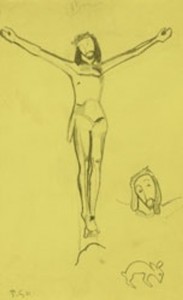 One of Tita's ten 'Gauguins (?)', which could become the subject of her forthcoming 'cleansing' operation (see ABC newspaper on 03.01.2010). 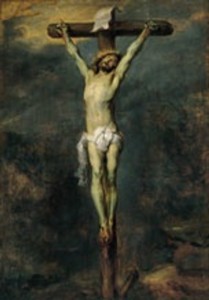 "'The Crucifixion', attributed to a painter from the circle of Sir Anthony van Dyck, which Heini purchased from Sotheby's at the 1995 sale of the Bentinck-Thyssen Collection for only £17,000 and immediately re-attributed to the Master himself" (from: 'The Thyssen Art Macabre' / 'La Historia Secreta de los Thyssen') |
Tags: ABC newspaper, Anthony van Dyck, Bentinck-Thyssen Collection, Carmen Cervera, Credit Crunch, Culture Ministry, Franz Hals, Gauguin, Juan Jose Junquera, Lugano, Malaga, Perez Sanchez, Prado, Sir Norman Rosenthal, Sotheby's, Spain, Taxpayer, Thyssen-Bornemisza Collection, Thyssen-Bornemisza Collection Foundation Board, Universidad Complutense, Villa Favorita
Posted in The Thyssen Art Macabre, Thyssen Art Comments Off on Thyssen Art Elevator Hits Spanish Buffers
Sunday, December 27th, 2009
This article by Matthew Campbell was published in today’s Sunday Times:
http://www.timesonline.co.uk/tol/news/world/article6968445.ece
Although it is indeed tempting to see this story as something of little more importance than a feature in Hola Magazine, there is a lot more to it, as you will see if you read my book, ‘The Thyssen Art Macabre’. For these are the same Thyssens who brought Hitler to power and were responsible for the slaughter of 180 Hungarian Jews at their Austrian castle in 1945.
And while many people believe this to be a world-class art collection, it is littered with fakes and second-class works, albeit brilliantly talked up by Heini Thyssen to the point where Spain paid in excess of $600 million to house half of it. (Contrary to the Sunday Times’s report, there was no ‘bequeathing’ involved).
The collection was only ever valued by one company: Sotheby’s, on whose board Heini Thyssen sat.
It seems highly likely that Tita Thyssen is frightened of Borja trying to sell any of the paintings, because the true value would then be revealed (as would the true ownership). |
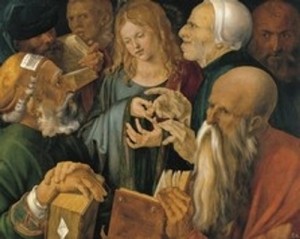 'Christ Among the Scribes', attributed by the Madrid Thyssen-Bornemisza Museum to Albrecht Dürer (1506) but described by the head of the Albrecht-Dürer-House in Nuremberg, Dr Thomas Schauerte, as an early 17th-century copy, a 'medley of references', showing a 'crass decline in quality' compared to Dürer's authentic works (see blog entry on 2 September 2009) |
Tags: Heini Thyssen, Hola Magazine, Matthew Campbell, Sotheby's, Sunday Times, Tita Thyssen
Posted in The Thyssen Art Macabre, Thyssen Art Comments Off on Thyssen Tussle Over Art Fortune (Sunday Times)
Saturday, November 28th, 2009
| The Argentinean actor, director and professor of drama, Ernesto Beltran Meza, writes on his blog (following a recent article in El Mundo):
La “guerra de los Thyssen” pone en alerta al mundo del arte
Las “Lágrimas de Eros” atraen estos días a miles de personas al Museo Thyssen-Bornemisza de Madrid. La exposición, un recorrido por el erotismo en la historia del arte, es todo un éxito. Lo que pocos visitantes saben es que detrás de la fachada del Palacio de Villahermosa, el edificio neoclásico que alberga a la pinacoteca, se libra una dura batalla por el legado de la familia que da nombre a una de las colecciones de arte más importantes del mundo. Esta batalla, que ya ha llegado a los tribunales, sí que ha hecho correr lágrimas, pero de ira y dolor, además de poner en peligro el futuro de ese patrimonio cultural.
Por un lado está Carmen “Tita” Cervera, ex “Miss España” y viuda del barón Hans-Heinrich Thyssen-Bornemisza, un acaudalado industrial y mecenas de nacionalidad suiza y origen húngaro-alemán que en 1992 vendió al Estado español su impresionante colección de 800 obras de arte por 400 millones de euros.
Por el otro está Borja, 29 años, el hijo de Carmen, fruto de una relación anterior a su matrimonio con el barón. Éste lo acogió como un hijo más y le dio su apellido. El joven afirma haber descubierto que es cobeneficiario de la colección de arte de su madre, compuesta por alrededor de 1.000 obras. Las piezas están valoradas nada menos en 800 millones de euros.
Cervera, que a sus 66 años es vicepresidenta del patronato de la Fundación Thyssen, demandó a su hijo ante tribunales, acusándolos de revelación de secretos y sustracción de documentos. Mientras que Borja reclama dinero, su madre intenta preservar su colección. Ésta incluye piezas fundamentales del arte moderno, además de importantes obras de Courbet, Corot, Monet, Pissarro, Sisley, Renoir, Degas, Gauguin, Braque, Matisse, entre otros.
So, I blogged him:
‘Dear Ernesto
Please forgive my writing to you in English, but my Spanish is not good enough.
I don’t mean to piss on your parade and it might sound to some as if I’m on a mission of hatred. I’m not. I got to know Heini and Tita Thyssen very well and liked them both (Tita is thought by many to be round the bend and a pain in the bum, but nonetheless, I like her).
Please don’t perpetuate stereotypical Thyssen myths. Heini’s forebears, and in particular his fortune, came from Germany. It was created by Old August Thyssen and thousands of dedicated, hard-working coal and steel workers. Switzerland and Hungary were merely conveniences.
While Heini’s collection is very impressive, it isn’t all it is said to be. Many art experts know that it contains many forgeries and paintings of a questionable provenance. It is also rather directionless, with no central theme and even where works are by genuine masters, they are mostly second-rate examples of their work.
The money for the collection, apart from that made by Old August, also includes profits from two world wars and the Thyssens’ involvement with the Nazi Party. It is not a background that gives any reason for pride.
The Thyssens have never been art ‘patrons’. They bought art; they did not pay artists to create it. They used art as a tax-efficient investment and a means of cloaking their past.
As far as Tita’s collection is concerned, while I admire the fact she has a personal taste, hers cannot, by any stretch of the imagination, be described as great art, and is certainly not worth, particularly in today’s climate, 800 million Euros, especially not to the Spanish, who have already paid for one Thyssen-Bornemisza Collection. They need two Thyssen-Bornemisza Collections like a hole in the head.
However, if you disagree with anything I say, there is always the option of your country renting Tita’s collection. I’m sure she would be delighted.’
Ernesto’s Blog has been going since 1987! |
 Ernesto Beltran Meza, ACTOR, DIRECTOR y PROFESOR DE TEATRO, egresado de Escuela Teatro La Plata, dependiente de DGCyE Pcia Bs As y PROFESOR DE ARTE EN TEATRO (Complementación Curricular de Grado) IUNA BUENOS AIRES - |
Tags: August Thyssen, Borja Thyssen, Carmen Tita Cervera, Degas, El Mundo, Ernesto Beltran Meza, Fundacion Thyssen, Gauguin, Hans Heinrich Thyssen, Lagrimas de Eros, Museo Thyssen-Bornemisza, Nazi Party, Palacio de Villahermosa, Pissarro
Posted in The Thyssen Art Macabre, Thyssen Art Comments Off on ThyssenArt Argentina
|














